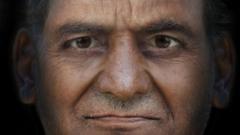How Did Researchers Recreate Faces from 2,500-Year-Old Indian Skulls?

In a groundbreaking study, researchers from Madurai Kamaraj University in Tamil Nadu are uncovering the mysteries of ancient civilisations through advanced facial reconstruction techniques. By analysing a 2,500-year-old tooth and skulls excavated from the Kondagai burial site, they aim to shed light on the early inhabitants of the region, revealing a complex tapestry of ancestry and cultural heritage.
Last updated: 25 October 2023 (BST)
Key Takeaways
- Research at Madurai Kamaraj University focuses on ancient human skulls from Kondagai, revealing a civilisation that thrived in southern India.
- Facial reconstructions indicate diverse ancestry, challenging traditional narratives about Indian heritage.
- Advanced techniques, including 3D scanning and digital modelling, are employed to recreate the faces of these ancient inhabitants.
- Ongoing excavations at Keeladi suggest an urban society existed well before the Indus Valley Civilisation.
- Challenges in extracting DNA from degraded samples highlight the difficulties in studying ancient populations.
The Discovery of Kondagai and Keeladi
The Kondagai burial site, located approximately 4 km from Keeladi, has become a focal point for archaeologists exploring the history of southern India. Excavations have uncovered approximately 50 burial urns containing human remains and artefacts, indicating a sophisticated urban culture that dates back to around 580 BC. This revelation challenges the long-held belief that urbanisation in India was predominantly a northern phenomenon.
According to Tamil Nadu state department archaeologists, the findings at Keeladi suggest that its inhabitants were literate, skilled artisans who engaged in trade both within the Indian subcontinent and internationally. The evidence of brick houses and the burial of daily necessities alongside the deceased further points to a complex societal structure.
Reconstructing Faces of the Past
At the heart of this research is the quest to reconstruct the faces of the ancient inhabitants whose skulls were discovered. The process began with the creation of 3D scans of the skulls, which were then sent to Face Lab at Liverpool John Moores University. Using forensic and artistic principles, experts at the lab added muscle, flesh, and skin to these scans, resulting in lifelike representations of the individuals.
Challenges of Facial Reconstruction
The addition of colour to the digital images posed significant challenges. Questions arose about the skin tones, eye colours, and hair types of the reconstructed individuals. Following standard practices, researchers chose colours based on the physical traits of contemporary Tamil Nadu residents. However, these choices sparked lively debates on social media, reflecting ongoing societal divisions regarding race and heritage in India.
Significance of Ancestral Insights
Professor G Kumaresan, who leads the genetics department at Madurai Kamaraj University, emphasises the importance of understanding the ancestry of these early inhabitants. The facial features derived from the reconstructions suggest a mix of Ancient Ancestral South Indian traits alongside influences from Middle-Eastern Eurasian and Austro-Asiatic populations. This genetic diversity hints at the complex migration patterns that have shaped the subcontinent's demographic history.
The Broader Implications of the Research
The implications of the discoveries at Keeladi extend beyond mere historical interest. They challenge the dominant narratives that have long portrayed northern India as the cradle of civilisation. By highlighting the existence of an urban society in southern India, this research contributes to a more inclusive understanding of India's past.
Insights into Daily Life and Culture
Research into the lifestyle of the Keeladi inhabitants reveals that they engaged in agriculture, trade, and livestock rearing. Evidence suggests they cultivated rice and millet, alongside raising deer, goats, and wild pigs. Intriguingly, findings also indicate that the people of Keeladi consumed dates, a food not typically associated with the region today.
Challenges in Extracting Ancient DNA
One of the most significant hurdles facing researchers is the extraction of DNA from the ancient skeletons found at Kondagai. Due to the degradation of these remains, the quality and quantity of DNA available for analysis are limited. Despite these challenges, Professor Kumaresan remains optimistic, noting that ancient DNA libraries can provide invaluable insights into the lives of past populations.
The Quest for Ancient Ancestry
The overarching goal of this research is to unravel the complex web of human ancestry and migration routes that led to the current population of India. This quest not only satisfies academic curiosity but also addresses broader questions of identity and heritage within a diverse nation.
Comparative Studies and Historical Context
This research is not the first attempt to reconstruct ancient faces in India. In 2019, scientists recreated the faces of skulls discovered at Rakhigarhi, a significant site within the Indus Valley Civilisation. However, those sketches lacked colour and detailed physical traits, highlighting the advancements made in the current study.
The Role of Facial Reconstructions in Historical Understanding
According to Caroline Wilkinson, who led the Face Lab team, facial depictions serve to humanise ancient remains, fostering a personal connection with history. By transforming skulls into recognisable faces, researchers encourage a deeper understanding of the lives these individuals led, rather than viewing them solely as artefacts of the past.
Future Directions and Research Opportunities
The ongoing investigations at Madurai Kamaraj University signify a commitment to understanding the Keeladi site with the same rigor applied to studies of the Indus Valley Civilisation. As researchers continue to uncover artefacts and extract DNA, the potential for new discoveries remains vast.
Encouraging Broader Community Engagement
As this research unfolds, it opens avenues for greater engagement with local communities and raises awareness about the rich history of southern India. The findings have the potential to reshape educational narratives and foster a sense of shared heritage among diverse groups.
Conclusion: Embracing Diversity in Ancestry
Ultimately, the work being done at Madurai Kamaraj University serves as a reminder of the intricate tapestry of human history. It challenges simplistic narratives of ancestry and highlights the rich diversity that has shaped the Indian subcontinent. As researchers continue to explore these ancient sites, they contribute not only to the academic field but also to a broader understanding of identity and belonging in a multicultural society.
As we reflect on these findings, one might ponder: how do our ancestral roots influence our identity today? Understanding this could pave the way for a more inclusive and harmonious future. #AncientCivilisations #DNAResearch #CulturalHeritage
FAQs
What is the significance of the Keeladi site?
The Keeladi site is significant as it suggests the existence of an urban civilisation in southern India around 580 BC, challenging the narrative that urban development was limited to northern India.
What techniques are used for facial reconstruction?
Facial reconstruction involves creating 3D scans of skulls, followed by digital modelling to add muscle, flesh, and skin, and finally applying colour based on contemporary physical traits.
What challenges do researchers face in extracting ancient DNA?
Researchers face challenges due to the degradation of skeletons, leading to low-quality and limited DNA samples, which complicates the analysis of ancient genetic material.
How does this research impact our understanding of Indian ancestry?
This research impacts our understanding by revealing a complex ancestry that includes diverse influences, demonstrating that the history of India is more intricate than previously thought.
What can we learn from the lifestyles of ancient inhabitants of Keeladi?
We can learn about their agricultural practices, trade relationships, and dietary habits, which included the consumption of rice, millet, and even dates, indicating a sophisticated society.
Published: 2025-08-23 22:49:09 | Category: technology



